Abstract
Substances from urinary extracts of normal, nonpregnant subjects and human pituitary gonadotropin preparations were found to react similarly to human chorionic gonadotropin (hCG) in a radioimmunoassay system that is highly specific for hCG and without crossreactivity to human luteinizing hormone (hLH). The antiserum was produced in a rabbit immunized with a bovine albumin conjugate of the unique carboxyl-terminal peptide (residues 123-145) isolated from a tryptic digest of the reduced, S-carboxymethylated hCGbeta subunit. The antibody recognition site on the peptide was found to reside on the last 15 amino acid residues of the carboxyl-terminal peptide, as evidenced by the competitive binding activities against 125I-labeled hCG of a series of peptides chemically synthesized according to the carboxyl-terminal sequence of HCGbeta. In order to elucidate the nature of the crossreacting substance in urinary extracts, a human postmenopausal urinary preparation (Pergonal) and a kaolin-acetone extract of urine from a patient with Klinefelter's syndrome were subjected to gel chromatography on Sephadex G-100. The results indicate that fractions showing immunocrossreactivity with the antiserum to hCGbeta-carboxyl-terminal peptide coeluted with 125I-labeled hCG which was separated distinctly from hLH. The same fractions from this postmenopausal urinary gonadotropin preparation exhibited in vitro biological activity proportional to the immunocrossreactivity of the hCG-specific antiserum. Concentration of postmenopausal women's urine by acetone precipitation retained approximately five times more immunoreactivity per unit volume than kaolin-acetone extraction, when assayed with the antiserum to hCGbeta-carboxyl-terminal peptide.
Full text
PDF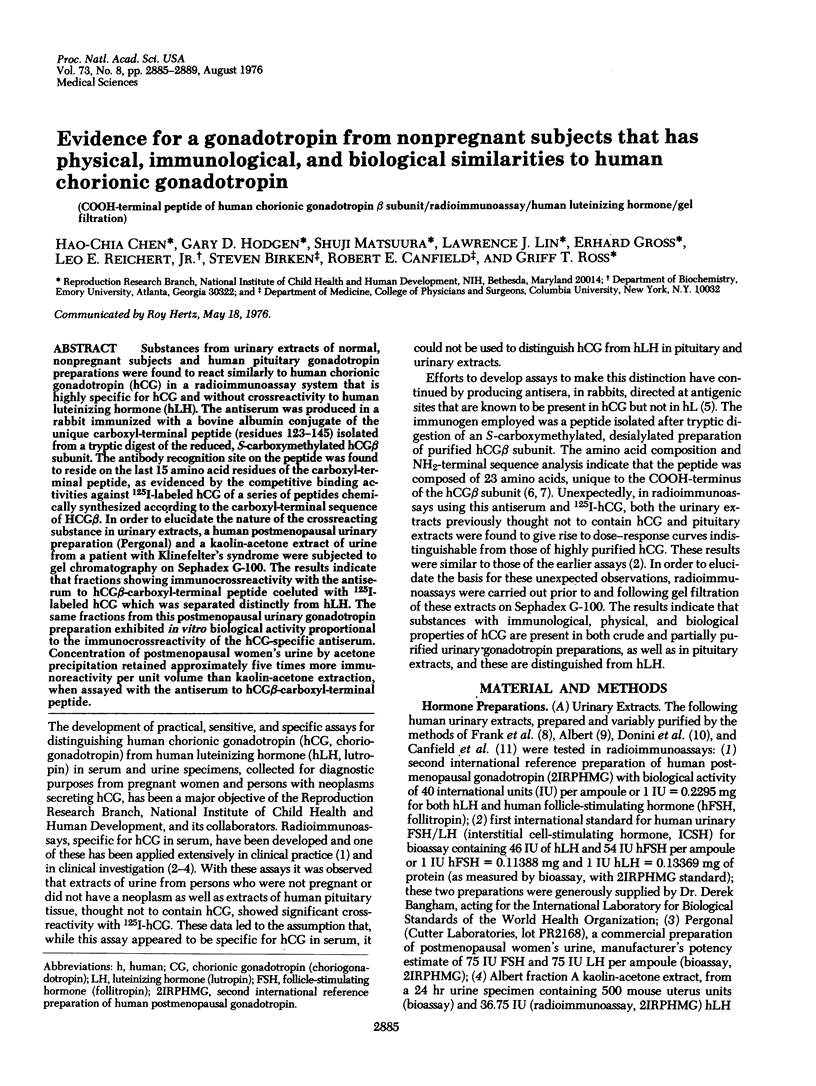
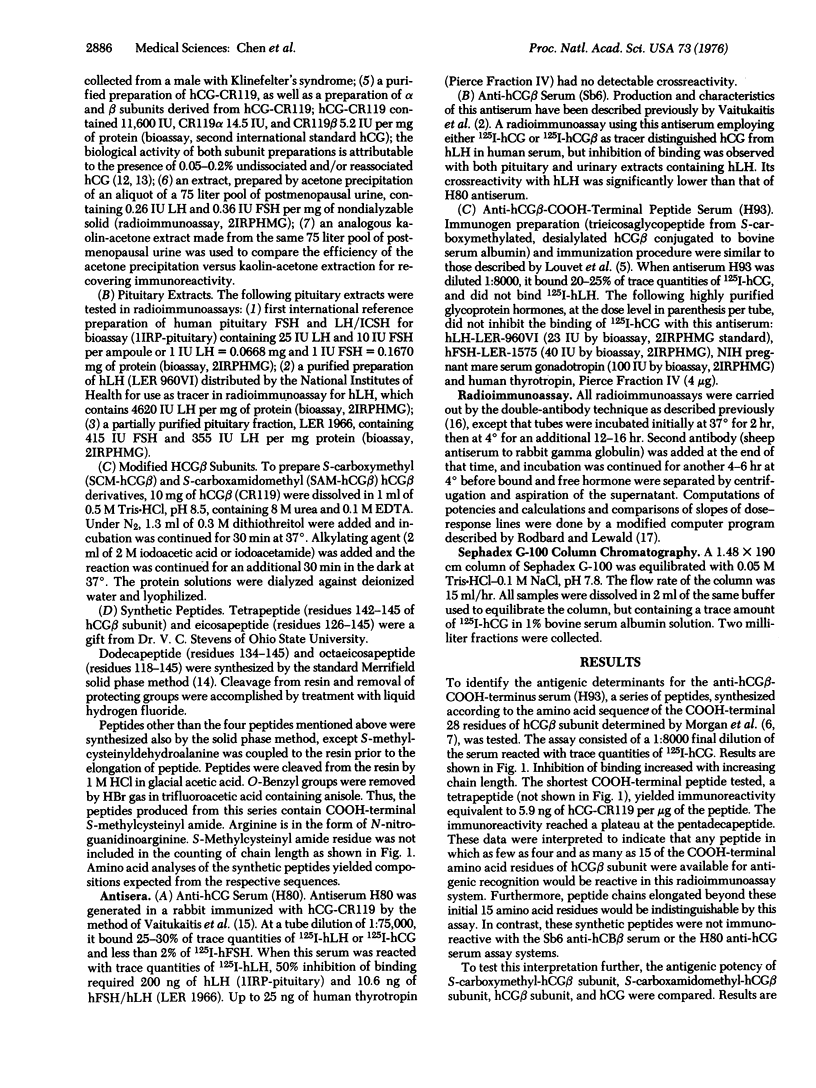
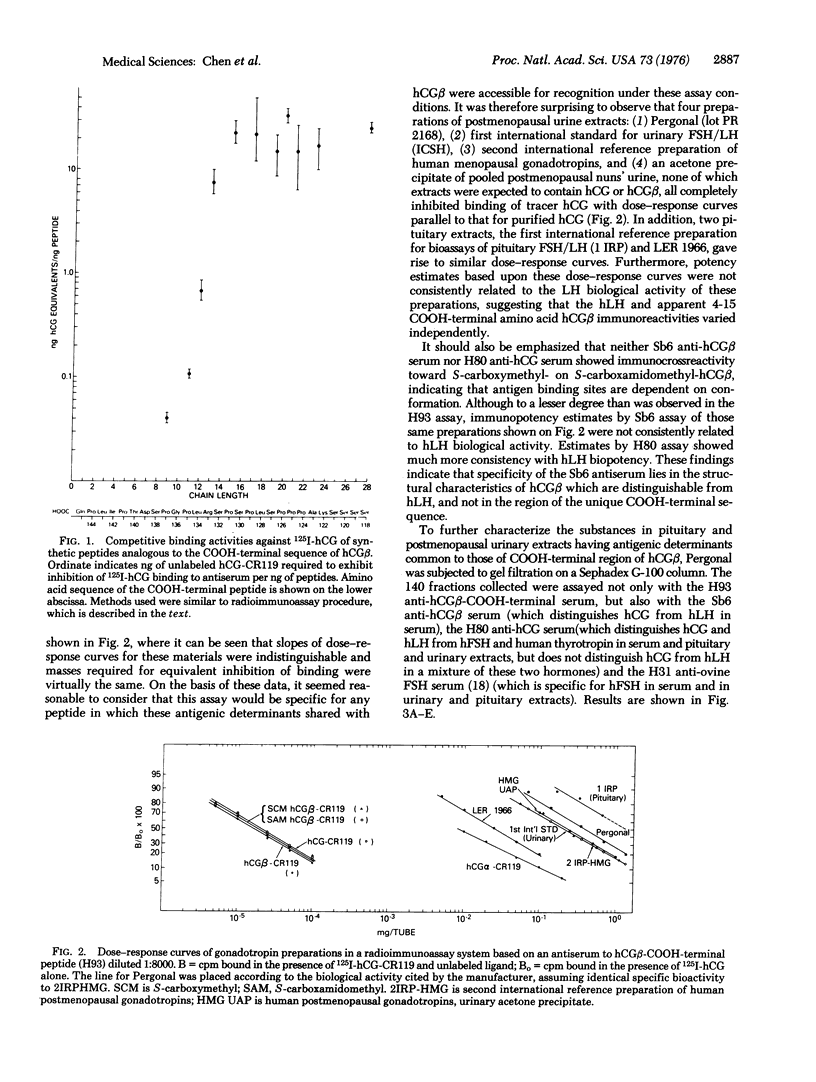
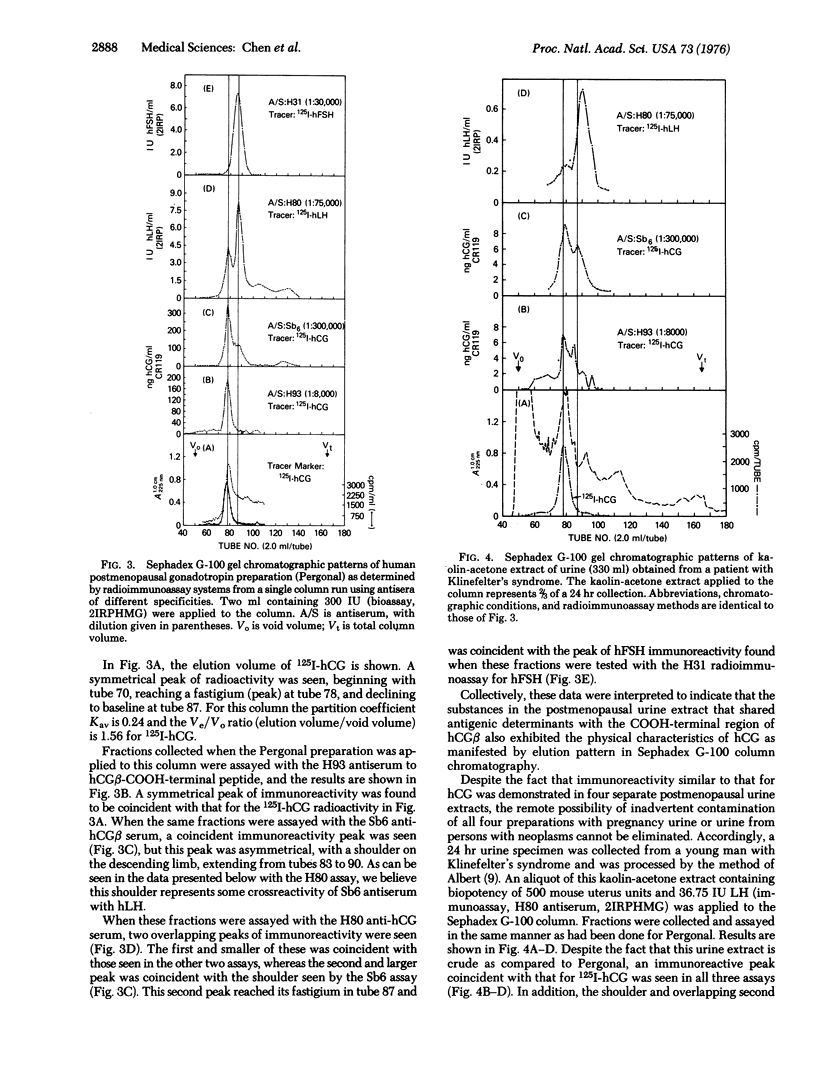
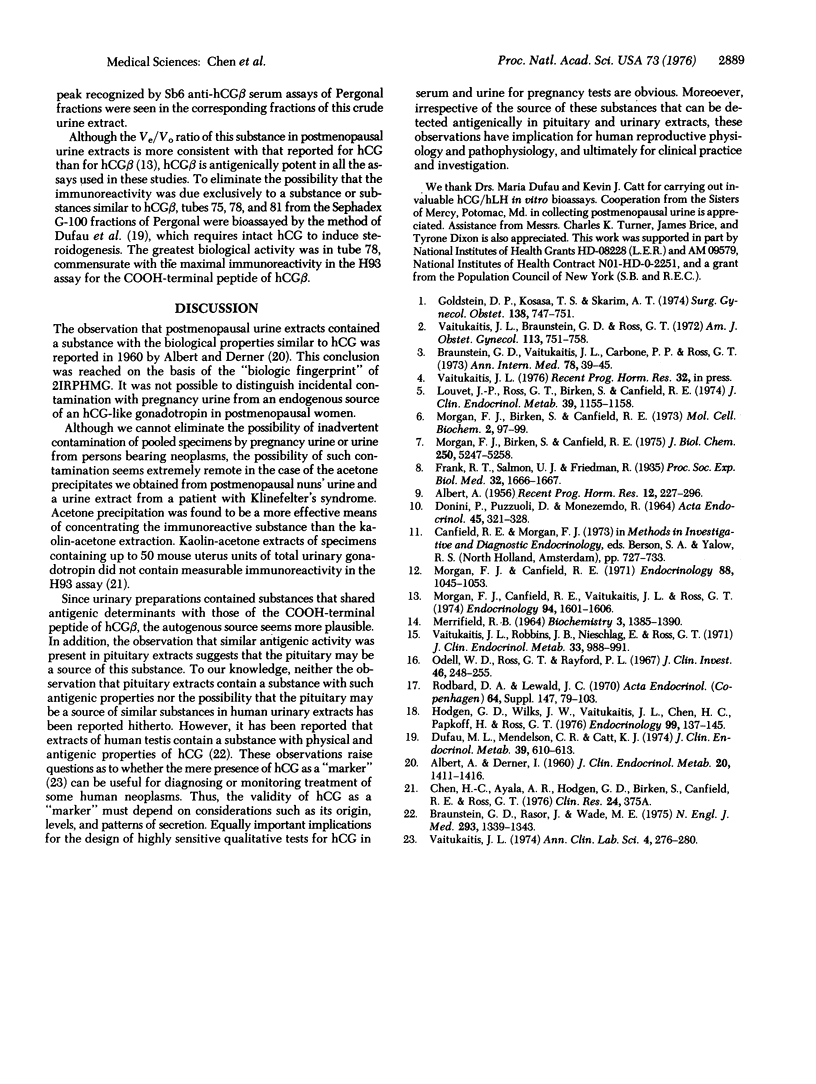
Selected References
These references are in PubMed. This may not be the complete list of references from this article.
- ALBERT A., DERNER I. Contamination of gonadotropin standards. J Clin Endocrinol Metab. 1960 Oct;20:1411–1416. doi: 10.1210/jcem-20-10-1411. [DOI] [PubMed] [Google Scholar]
- ALBERT A. Human urinary gonadotropin. Recent Prog Horm Res. 1956;12:227-96; discussion, 296-301. [PubMed] [Google Scholar]
- Braunstein G. D., Rasor J., Wade M. E. Presence in normal human testes of a chorionic-gonadotropin-like substance distinct from human luteinizing hormone. N Engl J Med. 1975 Dec 25;293(26):1339–1343. doi: 10.1056/NEJM197512252932603. [DOI] [PubMed] [Google Scholar]
- Braunstein G. D., Vaitukaitis J. L., Carbone P. P., Ross G. T. Ectopic production of human chorionic gonadotrophin by neoplasms. Ann Intern Med. 1973 Jan;78(1):39–45. doi: 10.7326/0003-4819-78-1-39. [DOI] [PubMed] [Google Scholar]
- DONINI P., PUZZUOLI D., MONTEZEMOLO R. PURIFICATION OF GONADOTROPHIN FROM HUMAN MENOPAUSAL URINE. Acta Endocrinol (Copenh) 1964 Mar;45:321–328. doi: 10.1530/acta.0.0450321. [DOI] [PubMed] [Google Scholar]
- Dufau M. L., Mendelson C. R., Catt K. J. A highly sensitive in vitro bioassay for luteinizing hormone and chorionic gonadotropin: testosterone production by dispersed Leydig cells. J Clin Endocrinol Metab. 1974 Sep;39(3):610–613. doi: 10.1210/jcem-39-3-610. [DOI] [PubMed] [Google Scholar]
- Goldstein D. P., Kosasa T. S., Skarim A. T. The clinical application of a specific radioimmunoassay for human chorionic gondotropin in trophoblastic and nontrophoblastic tumors. Surg Gynecol Obstet. 1974 May;138(5):747–751. [PubMed] [Google Scholar]
- Hodgen G. D., Wilks J. W., Vaitukaitis J. L., Chen H. C., Papkoff H., Ross G. T. A new radioimmunoassay for follicle-stimulating hormone in macaques: ovulatory menstrual cycles. Endocrinology. 1976 Jul;99(1):137–145. doi: 10.1210/endo-99-1-137. [DOI] [PubMed] [Google Scholar]
- Louvet J. P., Ross G. T., Birken S., Canfield R. E. Absence of neutralizing effect of antisera to the unique structural region of human chorionic gonadotropin. J Clin Endocrinol Metab. 1974 Dec;39(6):1155–1158. doi: 10.1210/jcem-39-6-1155. [DOI] [PubMed] [Google Scholar]
- MERRIFIELD R. B. SOLID-PHASE PEPTIDE SYNTHESIS. 3. AN IMPROVED SYNTHESIS OF BRADYKININ. Biochemistry. 1964 Sep;3:1385–1390. doi: 10.1021/bi00897a032. [DOI] [PubMed] [Google Scholar]
- Morgan F. J., Birken S., Canfield R. E. Letter: Human chorionic gonadotropin: a proposal for the amino acid sequence. Mol Cell Biochem. 1973 Nov 15;2(1):97–99. doi: 10.1007/BF01738683. [DOI] [PubMed] [Google Scholar]
- Morgan F. J., Birken S., Canfield R. E. The amino acid sequence of human chorionic gonadotropin. The alpha subunit and beta subunit. J Biol Chem. 1975 Jul 10;250(13):5247–5258. [PubMed] [Google Scholar]
- Morgan F. J., Canfield R. E. Nature of the subunits of human chorionic gonadotropin. Endocrinology. 1971 Apr;88(4):1045–1053. doi: 10.1210/endo-88-4-1045. [DOI] [PubMed] [Google Scholar]
- Morgan F. J., Canfield R. E., Vaitukaitis J. L., Ross G. T. Properties of the subunits of human chorionic gonadotropin. Endocrinology. 1974 Jun;94(6):1601–1606. doi: 10.1210/endo-94-6-1601. [DOI] [PubMed] [Google Scholar]
- Odell W. D., Ross G. T., Rayford P. L. Radioimmunoassay for luteinizing hormone in human plasma or serum: physiological studies. J Clin Invest. 1967 Feb;46(2):248–255. doi: 10.1172/JCI105527. [DOI] [PMC free article] [PubMed] [Google Scholar]
- Rodbard D., Lewald J. E. Computer analysis of radioligand assay and radioimmunoassay data. Acta Endocrinol Suppl (Copenh) 1970;147:79–103. doi: 10.1530/acta.0.065s079. [DOI] [PubMed] [Google Scholar]
- Vaitukaitis J. L., Braunstein G. D., Ross G. T. A radioimmunoassay which specifically measures human chorionic gonadotropin in the presence of human luteinizing hormone. Am J Obstet Gynecol. 1972 Jul 15;113(6):751–758. doi: 10.1016/0002-9378(72)90553-4. [DOI] [PubMed] [Google Scholar]
- Vaitukaitis J. L. Human chorionic gonadotropin as a tumor marker. Ann Clin Lab Sci. 1974 Jul-Aug;4(4):276–280. [PubMed] [Google Scholar]
- Vaitukaitis J., Robbins J. B., Nieschlag E., Ross G. T. A method for producing specific antisera with small doses of immunogen. J Clin Endocrinol Metab. 1971 Dec;33(6):988–991. doi: 10.1210/jcem-33-6-988. [DOI] [PubMed] [Google Scholar]


